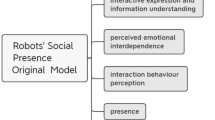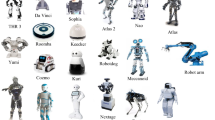Abstract
This article presents a method for measuring the quality of interaction in social mobile robotic telepresence. The methodology is in part based on Adam Kendon’s theory of F-formations. The theory is based on observations of how bodies naturally orient themselves during interaction between people in real life settings. In addition, two presence questionnaires (Temple Presence Inventory and Networked Minds Social Presence Inventory), designed to measure the users’ perceptions of others and the environment when experienced through a communication medium are used. The perceived presence and ease of use are correlated to the spatial formations between the robot and an actor. The proposed methodology is validated experimentally on a dataset consisting of interactions between an elder (actor) and 21 different users being trained in piloting a mobile robotic telepresence unit. The evaluation has shown that these tools are suitable for evaluating mobile robotic telepresence and also that correlations between the tools used exist. Further, these results give important guidelines on how to improve the interface in order to increase the quality of interaction.








Similar content being viewed by others
Notes
Hüttenrauch [14] discusses the conversion of distances into centimeters and stresses the need to refer to the original distances in feet by Hall, p. 41.
The alarm operators respond to alarms coming from elderly who by pushing a button on a necklace get in direct contact with the service. The training session was a preparation for participation in a larger study in which the Giraff would be deployed, used and evaluated with two elderly in a real home. One of which was using a wheelchair.
The environment [27] is located at AASS (Center for Applied Autonomous Sensor Systems) which is a research center at Örebro University, Sweden.
The original instruction movie for the participants was Swedish. An English version can be downloaded by clicking on “Giraff User’s Guide” at: http://www.oru.se/ExCITE/Part-3/User-manuals/English/.
References
Adalgeirsson SO (2009) Mebot: a robotic platform for socially embodied presence. Master’s thesis, Massachusetts Institute of Technology
Adalgeirsson SO, Breazeal C (2010) Mebot: a robotic platform for socially embodied presence. In: Proceedings of HRI 2010, pp 15–22
Argyle M, Dean J (1965) Eye-contact, distance and affiliation. Sociometry 28:3
Beer JM, Takayama L (2011) Mobile remote presence systems for older adults: acceptance, benefits, and concerns. In: Proceedings of HRI 2011, pp 19–26
Biocca F, Harms C (2011) Guide to the networked minds social presence inventory. http://cogprints.org/6743/. Accessed 6 November 2011
Biocca F, Harms C (2011) Networked minds social presence inventory (scales only version 1.2). Tech. rep, M.I.N.D. Labs, Michigan State University, Michigan, USA (2002). http://cogprints.org/6742/. Accessed 6 November 2011
Cohen B, Lanir J, Stone R, Gurevich P (2011) Requirements and design considerations for a fully immersive robotic telepresence system. In: Proceedings of HRI 2011 workshop on social robotic telepresence, pp 16–22
Giraff: http://www.giraff.org. Accessed 6 Nov 2011
Gottdiener M (1979) Field research and video tape. Sociol Inq 49(4):59–66
Hall ET (1966) The hidden dimension: man’s use of space in public and private. Bodley Head, London
Heath C, Luff P (1991) Disembodied conduct: communication through video in a multi-media environment. In: Proceedings of CHI 1991, pp 99–103
Hoffman L, Krämer NC (2011) How should an artificial entity be embodied? Comparing the effects of a physically present robot and its virtual representation. In: Proceedings of HRI workshop on social robotic telepresence (2011)
Hornecker E (2005) A design theme for tangible interaction: embodied facilitation. In: Proceedings of ECSCW 2005, pp 23–43
Hüttenrauch H (2006) From hci to hri: designing interaction for a service robot. PhD thesis, KTH Computer Science and Communication
Hüttenrauch H, Topp E, Severinson-Eklundh K (2009) The art of gate-crashing bringing hri into users’ homes. Interact Stud 10(3):275–298
Jouppi N, Thomas S (2005) Telepresence systems with automatic preservation of user head height, local rotation, and remote translation. In: Proceedings of ICRA 2005, pp 62–68
Kendon A (1990) Conducting interaction: patterns of behavior in focused encounters. Cambridge University Press, Cambridge
Kendon A (2010) Spacing and orientation in co-present interaction. In: Development of multimodal interfaces: active listening and synchrony. Lecture notes in computer science, vol 5967, pp 1–15
Kristoffersson A, Coradeschi S, Severinson-Eklundh K, Loutfi A (2011) Sense of presence in a robotic telepresence domain. In: Proceedings of UAHCI 2011, vol II, pp 479–487
Kuzuoka H, Suzuki Y, Yamashita J, Yamazaki K (2010) Reconfiguring spatial formation arrangement by robot body orientation. In: Proceedings of HRI 2010, pp 285–292
Lee MK, Takayama L (2011) “Now, i have a body”: uses and social norms for mobile remote presence in the workplace. In: Proceedings of CHI 2011, pp 33–42
Lombard M, Ditton T (2004) A literature-based presence measurement instrument the temple presence inventory (tpi) (beta). Tech. rep., M.I.N.D. Labs, Temple University, Pennsylvania, USA. http://matthewlombard.com/research/P2scales_11-04.doc. Accessed 6 November 2011
Marshall P, Rogers Y, Pantidi N (2011) Using f-formations to analyse spatial patterns of interaction in physical environments. In: Proceedings of CSCW 2011, pp 445–454
Meisner R, von Lehn D, Heath C, Burch A, Gammon B, Reisman M (2007) Exhibiting performance: co-participation in science centres and museums. Int J Sci Educ 29:1531–1555
Michaud F, Boissy P, Labonté D, Corriveau H, Grant A, Lauria M, Cloutier R, Roux MA, Iannuzzi D, Royer M-P (2007) Telepresence robot for home care assistance. In: Proceedings of AAAI spring symposium on multidisciplinary collaboration for socially assistive robotics 2007
QB: http://anybots.com. Accessed 6 November 2011
Saffiotti A, Broxvall M (2005) PEIS ecologies: ambient intelligence meets autonomous robotics. In: Proc of the int conf on smart objects and ambient intelligence (sOc-EUSAI), Grenoble, France, pp 275–280
Tsui KM, Desai M, Yanco HA, Uhlik C (2011) Exploring use cases for telepresence robots. In: HRI’11, pp 11–18
VGo: http://www.vgocom.com/. Accessed 6 November 2011
Yamaoka F, Kanda T, Ishiguro H, Hagita N (2010) A model of proximity control for information-presenting robots. IEEE Trans Robot 26(1):187–194
Acknowledgements
The authors would like to acknowledge Prof. Silvia Coradeschi for her support in the project and Martin Längkvist and Federico Pecora for participating in the experiment. We would also like to thank Rafael Muñoz Salinas, Enrique Yeguas Bolívar and Luis Díaz Mas for technical support with video recording.
Author information
Authors and Affiliations
Corresponding author
Additional information
The ExCITE project has been supported by EU under the Ambient Assisted Living Joint Programme (AAL-2009-2-125).
Appendix: Supporting Definitions on Presence
Appendix: Supporting Definitions on Presence
The level of co-presence “is influenced by the degree to which the user and the agent appear to share an environment together, p. 5” [5]. The co-presence as used in this study consists of only four questions:
-
1.
I felt that x and I were in the same place.
-
2.
I believe that x felt as if we were in the same place.
-
3.
I was aware of that x was there.
-
4.
x was aware that I was there.
The attentional engagement “seek to measure the degree to which the users report attention to the other and the degree to which they perceive the other’s level of attention towards them, p. 10” [5]. The Attentional engagement as used in this study only contains two questions:
-
1.
I payed attention to x.
-
2.
x payed attention to me.
Comprehension is the degree to which the user and the other understand their respective intentions, thoughts etc. In total six questions were asked in the dimension, examples include:
-
1.
I could communicate my intentions to x in a clear way.
-
2.
x could communicate his/her intentions to me in a clear way.
-
3.
My thoughts were clear to x.
-
4.
I could understand what x meant.
Rights and permissions
About this article
Cite this article
Kristoffersson, A., Severinson Eklundh, K. & Loutfi, A. Measuring the Quality of Interaction in Mobile Robotic Telepresence: A Pilot’s Perspective. Int J of Soc Robotics 5, 89–101 (2013). https://doi.org/10.1007/s12369-012-0166-7
Accepted:
Published:
Issue Date:
DOI: https://doi.org/10.1007/s12369-012-0166-7




